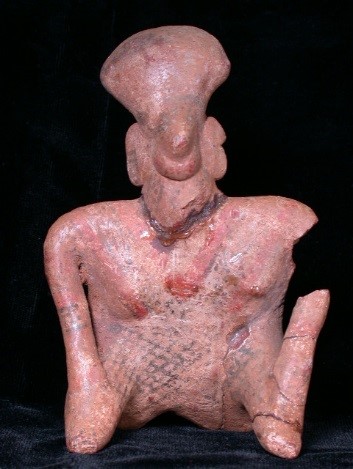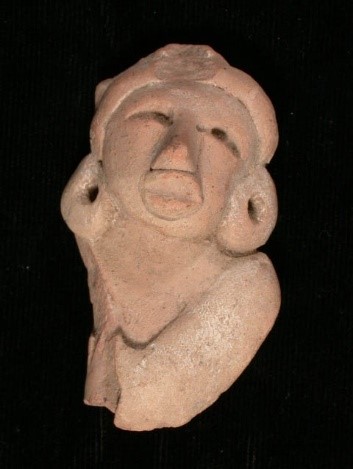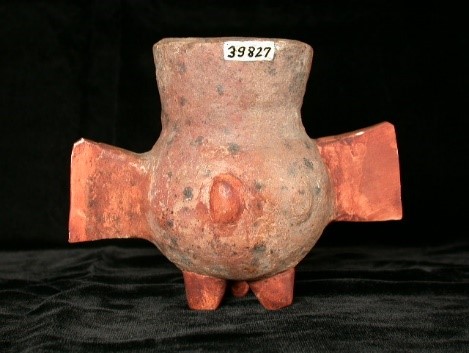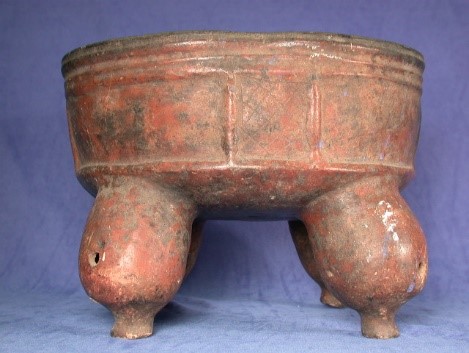Plate 1.
85-8-12
Mexico
Nayarit, Protoclassic (100 B.C.– A.D. 300)
Kneeling Female Figurine
Fired Clay
Dimensions: H 11.5 cm x W 8 cm x D 4.5 cm
(NX)
This figurine style can be traced back to the Protoclassic period (100 BC-AD 300) in Nayarit, one of the three states that comprise West Mexico. The Protoclassic in West Mexico is known for shaft tombs, characterized by an entrance shaft and one or two chambers. Some ceramic pieces recovered in shaft tombs indicate trade with the central Mexican city of Teotihuacan during the Classic period (AD 200-600), although these foreign ceramics appear as the shaft tomb complex was waning, perhaps due to the rising power of Teotihuacan.[1] West Mexican tombs held multiple individuals whose high status was indicated by rich offerings of clay figurines representing animals and people, many shown in ritual scenes. Groups of figures characteristic of Nayarit include scenes with many figures involved in ball games, ceremonies, and panoramas of daily life.[2] Grave offerings of small, solid figurines like this one are characteristic of lower status burials in Nayarit.[3] This figure belongs to the Ixtlán del Río style, distinguished by pinched, protuberant noses, multi-looped earrings and nose rings. Breasts and a textile skirt identify this as a female.
Similar examples:
- Taube 1989:fig. IV-20.
- Kan et al. 1989:figs. 31 and 35.
- Winning and Hammer 1972:fig. 63.
[1] Taube 1989:57.
[2] Butterwick 2004:33-43; Kan et al. 1989:33-43, figs. 29-35; Taube 1989:58.
[3] Kan et al. 1989:33-43.a.
Plate 2.
A3921
Mexico
Valley of Mexico, Preclassic (900-500 BC)
Figurine Head and Torso
Fired Clay
Dimensions: H 6.5 cm x W 3.6 cm
(NX)
Middle Preclassic figurines like this one have been recovered from elite burials and caches, which may have been deposited to sanctify the locations for continuing communication with the ancestors.[1] These figurines may demonstrate interaction between the Valley of Mexico and Olmec sites on the Gulf Coast. Examples like this one belong to Type A of the Middle Preclassic Zacatenco phase (900-500 BC), described as having an “Olmecoid mouth and perforated eyes,” allowed archaeologists to identify an Olmec presence in Central Mexico.[2] Subsequent excavations in and around the Valley of Mexico at sites like Tlatilco, Zacatenco, Copilco, Chalcatzingo, and Tepatlaxco have also revealed the presence of a West Mexican influence, placing the Basin of Mexico at a crossroads that allowed it to form connections to both its east and west.[3]
Similar Examples:
- Gamio 1920:fig. 8.
- Piña Chan 1958:fig. 32.
- Piña Chan 1971:figs. 14b and 18b.
[1] Marcus 2009:29.
[2] Piña Chan 1958:72-73, 1971:170. Quote in Piña Chan 1971:170.
[3] Marcus 2009:35-37; Plunket and Uruñuela 2012:12; see also Blomster et al. 2005; Pool et al. 2010; Rosenswig 2010; and Stark 2007.
Plate 3.
39827
Central Mexico
Aztec, Postclassic (A.D. 1325-1521)
Tripod Jar with Flanges
Painted Pottery
Dimensions: H 11.4 cm x D 8.3 cm
(NX)
A representation of Tlaloc, the central Mexican rain god during the Late Postclassic (AD 1325-1521), this vessel has lost the most recognizable features of this deity, such as his goggle eyes, handlebar mustache, and fangs.[1] Faint remnants of the eyes still survive but other characteristics of Tlaloc vessels are notable, such as the prominent flanges and small nubbin nose. Moreover, the vessel has an olla shape and long neck typical of Tlaloc vessels. At least as far back as Classic Teotihuacan (200 BC – AD 600), Tlaloc was associated with rain, fertility, and agriculture. During the Postclassic, Tlaloc was also linked with mountains, springs, and caves, and he had a shrine dedicated to him on Mount Tlaloc in the Valley of Mexico.[2] In addition, Tlaloc played a role in legitimizing political power for the Mexica Aztecs.[3]
Similar Examples:
- Winfield 2014:figs. 8, 10, 11.
[1] Bonifaz Nuño, 1986:100; Pasztory 1988:290.
[2] Pasztory 1998:24.
[3] Paztory 1988:292-294.
Plate 4.
A5243
Guatemala
Maya, Protoclassic (50 BC-AD 250)
Tetrapod bowl
Pottery
Dimensions: H 16 cm x D 23 cm
(NX)
Mammiform tetrapod bowls like this one, typical of the Protoclassic (50 BC-AD 250) in the Maya lowlands, represent a clear departure of preexisting Maya ceramic traditions in terms of vessel form, surface treatment, and decoration. New forms include bowls with four breast-shaped supports like this example, which also has the orange glossy slip characteristic of this period.[1] The cross-hatch motifs seen here were common in Protoclassic ceramics, and other forms of decoration include animals and parallel black lines, and step-fret motifs.[2] The origin point of mammiform vessels remains unknown. Although many of these vessels were locally produced throughout the lowland Maya region, the most widely distributed type is the Ixcanrio Orange Polychrome, spanning from the Pasión drainage in east central Guatemala to Belize.[3] The symbolism of mammiform vessels is associated with the Maya moon goddess, later known as Ix Chel, who controlled monthly cycles, female fertility, and childbirth. Trade in these vessels also served as political currency in renewed alliances established after the decline of El Mirador at the end of the Late Preclassic in the Peten.[4]
Similar examples:
- Brady et al. 1998:fig 1f.
- Masson and Freidel 2002:fig. 4.9.
- Schmidt et al. 1998:fig. 411.
[1] Brady et al. 1998:17-18.
[2] Lothrop et al. 1964:161; Masson and Freidel 2002:103; Schmidt et al. 1998:644.
[3] Masson and Freidel 2002:102.
[4] Masson and Freidel 2002:104-105.
Plate 5.
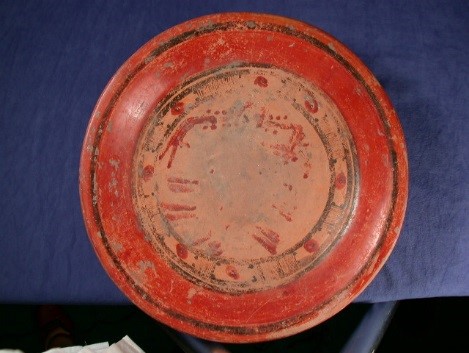
A5210
Guatemala
Maya, Late Classic (AD 600-900)
Tripod Plate
Polychrome Pottery
Dimensions: H. 9.6 cm x D 33.2 cm
(NX)
Showing the faint outline of a dancer with a feathered headdress, this tripod plate is an example of the Classic Maya “dancer plates” originating at the site of Tikal, Guatemala and nearby workshops in subsidiary sites such as Uaxactun.[1] Although few of these vessels have been excavated in controlled archaeological contexts, chemical and stylistic analyses have aided in identifying their region of origin.[2] These plates generally feature a dancing male with a raised leg and bent knee, flying loincloth flaps and outcast arms.[3] The tripod feet and crenelated basal flange on our example are also characteristic of dancer plates, which were used primarily as funerary vessels holding food offerings for the dead.[4] The dancers may symbolize the soul’s dance of apotheosis after defeating the Maya Lords of Death.[5] These plates may have been used as service vessels and items of social currency exchanged by elites throughout the Petén.[6]
Similar Examples:
- Reents-Budet 1994:figs. 5.37, 5.38, and 5.39.
- Schmidt et al. 1998:figs. 337 and 338.
- Zralka et al. 2011:fig. 5.
[1] Reents-Budet 1994:197-198.
[2] Źrałka et al. 2011:894-895.
[3] Reents-Budet 1994:197; Schmidt et al. 1998:603.
[4] Schmidt et al. 1998:603.
[5] Reents-Budet 1994:198.
[6] Reents-Budet 1994:198; Źrałka et al. 2011:904.
Plate 6.
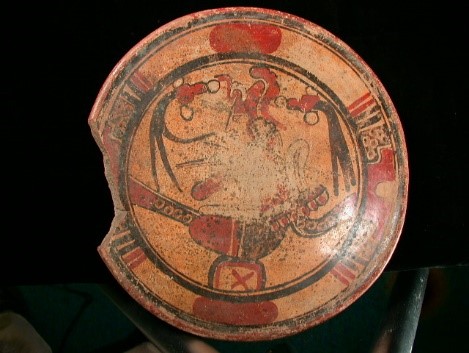
A5240
Guatemala/Southern Mexico
Maya, Late Classic (A.D. 600-900)
Tripod Plate
Polychrome Pottery
Dimensions: D 27 cm x H 5 cm (legs broken off)
(NX)
Late Classic (AD 500-900) Maya polychrome pottery was a prime medium for artistic renderings of Maya individual, deities, and elite events.[1] Here we can see the Maya Maize God is identified by his characteristic elongated head and tonsured coiffure resembling a corn husk and silk.[2] Maya lords associated themselves with the Maize God to make the claim that their dynastic line regenerated like the agricultural cycle, passing from their dead ancestors to their progeny.[3] Although some of these plates have been recovered in funerary contexts, eroded interior surfaces as in this example suggest their use as service wares in ritual events. [4] Such plates were probably used in elaborate elite feasts representing status contests that established reciprocal obligations.[5]
Similar Examples:
- Just 2009:fig. 5.
- Fields et al. 2005:Pl 21.
[1] Reents-Budet 1994:72; Rice 2009:77.
[2] Just 2009:4; Fields 1991:172-173.
[3] Taube 1985:180.
[4] Just 2009:4-8, 10-14; Reents-Budet 1994:74-75.
[5] Just 2009:4; Rice 2009:78.
Plate 7.
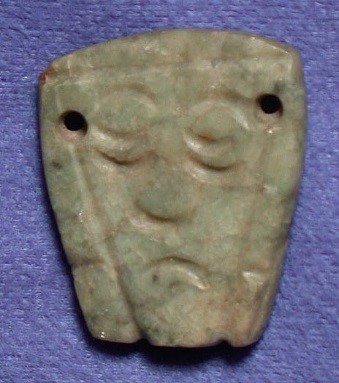
P2277
Mexico
Maya, Late Classic (A.D. 600-900)
Pendant with a human face
Carved jade
Dimensions: H 3
(NX)
Found in southern Mexico and Central America during the Late Classic period (AD 600 – 900), jade pendants like this one represent the “drooping mouth” style, created with tubular hollow drills, spun rapidly to make perforations and delineate facial features.[1] Similar jade pendants have been found in southern Mexico in Oaxaca at the Zapotec site of Monte Alban and in the Maya Peten of Guatemala, and they were also among the offerings made by pilgrims to the Great Cenote of Chichen Itza.[2] Pieces such as this one probably originated in the Maya area, near the source jade in eastern Guatemala, and were traded north to Oaxaca. They appeared at Monte Alban around the time that Maya trade wares such Plumbate and Fine Orange first appeared at the site in the Terminal Classic.[3]
Similar Examples:
- Caso 1965:fig. 30.
- Coggins and Shane:fig. 8.
- Taube 1989:fig. IV-5.
- Winning 1986:fig. 173.
[1] Coggins and Shane 1984:36; Taube 1989:111.
[2] Coggins and Shane 1984:36; Taube 1989:111.
[3] Caso 1965:906-908; Bey et al. 1997:249.
Plate 8.
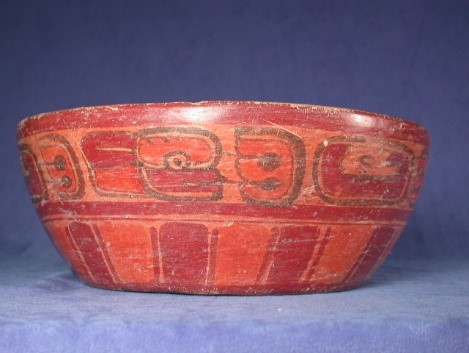
A5235
Honduras or El Salvador
Maya, Late Classic (A.D. 600-900)
Copador Bowl
Polychrome Pottery
Dimensions: H 8 cm x D 20.6 cm
(NX)
Painted pseudoglyphs and geometric designs executed in red hematite and black and orange paint are typical of the Copador style. Other designs include human and animal representations.[1] Copador is a type of ceramics found in western El Salvador and eastern Honduras around the site of Copan, its name being a contraction of Copan and El Salvador in reference to its zone of distribution.[2] During the Late Classic period these two areas had close ties, and Copador distribution spanned across ethnic and political boundaries, linking local elites to the great Maya city of Copan.[3] Copador pottery was made of clay from two sources of differing depositional history within the Copan Valley and subsequently traded widely throughout the southern periphery of Mesoamerica.[4]
Similar Examples:
- Demarest 1988:fig. 27.
- Longyear 1944:fig. 14.
- Schmidt et al. 1998:fig. 502.
[1] Beaudry 1987:228; Longyear 1944:Pl. X, fig. 23.
[2] Glass 1966:161; Schmidt et al. 1998:646.
[3] Demarest 1988:377-380; Longyear 1966:151.
[4] Beaudry 1983:117; 1987:228; Demarest 1988:377.
Plate 9.

A5238
Guatemala
Maya, Late Classic (A.D. 600-900)
Incense Burner
Orange paste pottery
Dimensions: H 17 cm x D 32 cm
(NX)
Maya censers such as this Late Classic example often feature jaguar imagery. Maya feline imagery may be associated with the Jaguar God of the Underworld, sometimes identified as the ‘night-sun” or a lunar god.[1] The spikes on these incense burners have been variously interpreted as representation of the sun’s rays, ceiba spines, fruit protuberances, or the spots on a jaguar or the skin of a crocodile earth-monster.[2] Spiked vessels are very widespread in the Maya area during the Late Classic, and most probably were used for offerings or burning incense in public rituals.[3] Spiked vessels also appear in rituals shown in Postclassic Maya painted books, especially the Dresden Codex and the Paris Codex.[4]
Similar examples:
- Shimbunsha 1974:figs. AO.1 and AO.5.
[1] Halperin 2014:131-132; Milbrath 1999:124; Thompson 1950:11-12.
[2] Rice 1999:34-36.
[3] Deal 1982:625-626; Halperin 2014:133.
[4] Deal 1982:623-625; Rice 1999:26.
Plate 10.
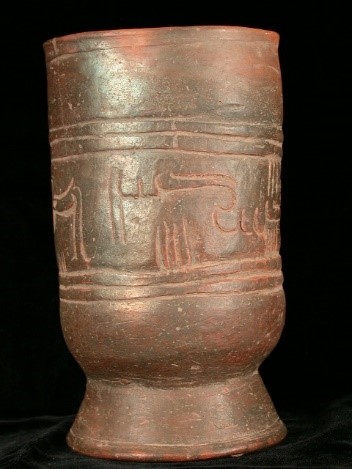
A5242
Guatemala
Maya, Early Postclassic (A.D. 900-1150)
Pedestal vase
Plumbate Pottery
Dimensions: H 19 cm x D 11 cm
(NX)
This vase is a classic example of Tohil Plumbate, a type of pottery that originated in southwestern Guatemala during the Early Postclassic period (AD 900-1150). Plumbate is the only Prehispanic pottery in the Americas to have a true glaze. The glaze itself and its color are the result of the high lead content in the clay.[1] Plumbate is very durable, being tempered with feldspar fired at high temperatures upward of 950º centigrade.[2] Tohil Plumbate pottery gets its name from the Tohil phase of Zacualpa in the Quiché Department of Guatemala but it was widely distributed in Mesoamerica through trade.[3] Some Tohil plumbate pottery depicts anthropomorphic effigies and deities from the central Mexican pantheon, such as Tlaloc and Xipe Totec, suggesting a non-Maya origin for the potters.[4] More typical forms are like this pedestal vase, decorated with an incised band of pseudoglyphs.
Similar Examples:
- Sachse 2001:Pl. 564.
- Rands and Smith 1965:fig 18f.
[1] Sachse 2001:359-360.
[2] Rands and Smith 1965:135.
[3] Schmidt et al. 1998:519-520.
[4] Rands and Smith 1965:135.
Plate 11.
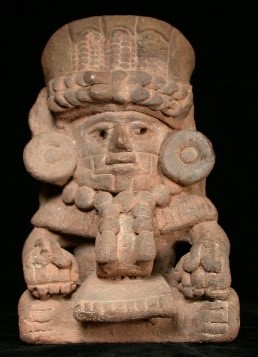
94234
Maize God Funerary Urn
Mexico, Zapotec, Oaxaca
Classic, Monte Alban IIIa (A.D. 300-600)
Fired Clay
Dimensions: H 21.59 cm
(NZ)
The Maize God represented in this funerary urn is one of many gods that was revered in the Zapotec culture (600 BC to 900 AD). In Zapotec he was known as Pitao Cozobi, “God of Abundant Sustenance,” a benevolent god that provided life to the people.1 The Maize God is also referred to as the “God of Glyph L,” in classification systems developed by archaeologists.2 Sitting cross-legged, he wears a headdress featuring corn cobs (maize), large ear plugs, a jade necklace, and a loin cloth.
Zapotec urns usually depict different gods that are representative of the forces of nature.3 These urns were placed as offerings in tombs and temples. This figure is quite simple when compared to other elaborate Maize God urns. Unlike many other Zapotec Maize God urns, this one lacks a nasal mask. He also has a stepped design around its mouth, an interesting overlap with the Maya maize god.
Similar Examples:
- Yale University Art Gallery number 1973.88.10.
- Parsons 1980:Pls. 212, 224.
[1] Boos 1966:177.
[2] Yale Art Gallery, n.d.
[3] Paddock 1966:153.
[4] Yale Art Gallery, n.d.
Plate 12.
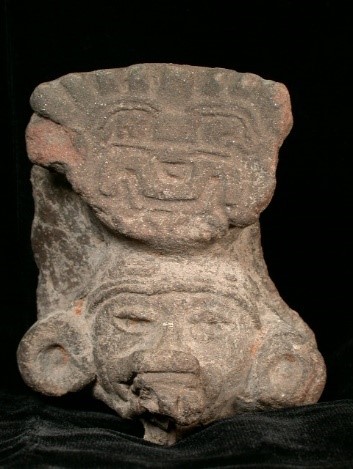
P2306
Mexico
Oaxaca, Early Classic (A.D. 300-600)
Funerary Urn
Pottery
Dimensions: H 11 cm x W 9 cm
(NX)
This vessel fragment represents Cocijo, the Zapotec god of rain and lightning, identified by a headdress with an undulating symbol called Glyph C, sometimes interpreted as a stylized representation of a jaguar, or the face of the Earth Monster.[1] These funerary urns may represent ancestors disguised as Cocijo and it is possible that the Zapotec made no significant distinction between the deity and deified ancestors, whom they addressed to intercede in their behalf.[2] Animal representations of deities embodied the abstract forces in the universe, and also reinforced a lineage-based power structure.[3] Use of this type of effigy vessel is linked to increased interaction between Monte Alban and Teotihuacan in central Mexico during the Classic period, although the contexts are different because the Teotihuacan effigy vessels were used for burning incense.[4]
Similar Examples
- Easby et al. 1970:figs. 157 and 158.
- Paddock 1966:figs. 116, 176, 268.
- Parsons 1974:figs 137b.
[1] Easby et al. 1970:196; Masson 2001:14; Sellen 2002:8.
[2] Masson 2001:8; Renfrew and Zubrow 1994:61.
[3] Masson 2001:26-27; Paddock 1966:153.
[4] Plunket 2002:78.
Plate 13.
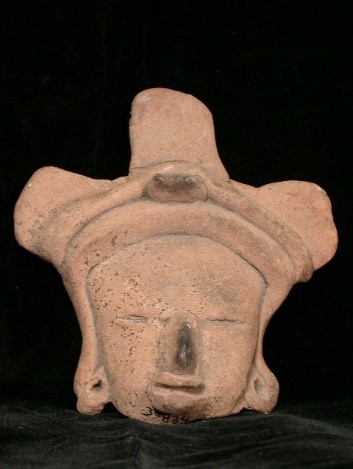
39834
Mexico
Central Veracruz, Early Classic (A.D. 200-550)
Figurine Head with Tripartite Headdress
Fired Clay
Dimensions: H 10.88 cm x W 11.4 cm
(NX)
This figurine head is an example of the Rancho de las Animas type of the Upper Remojadas I (AD 200-550) period, first identified at Cerro de las Mesas in Veracruz. The characteristic simplicity of this type of figurine includes slits for eyes and the extensive use of appliqué for the nose, mouth, headdress, and earplugs.[1] Examples such as this one have also been described as “Triangular Face Type” as a presumable attempt by artists’ attempts to depict front-occipital cranial deformation.[2] Its headdress with three tufts of hair is similar to rattling whistles of the same period excavated in the area.[3] Hand-made figurines with mold-made heads such as this one, created complex drapery, jewelry, headdress, and facial expressions with simple clay forms.[4] Its head shape, as well as the dress and stance of similar figurines are reminiscent of the art of Teotihuacan during the Early Classic Miccaotli Phase (c. AD 200).[5]
Similar Examples:
- Drucker 1943:fig. 40g.
- Hammer 1971:fig. 27.
- Kubler 1984:fig. 102.
[1] Drucker 1943:64; Hammer 1971; Kubler 1984:148.
[2] Hammer 1971:25.
[3] Medellín Zenil 1987:88.
[4] Kubler 1984:148-149.
[5] Cowgill 1997:133; Hammer 1971:25; Weaver 1972:145.
Plate 14.
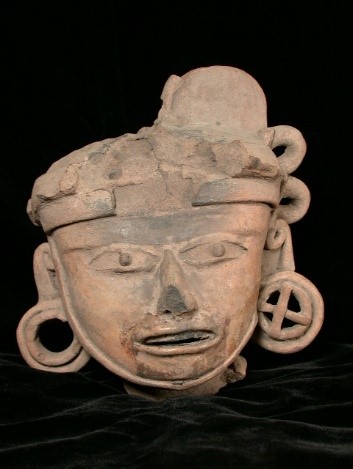
P2313
Mexico
Veracruz, Late Classic (A.D. 550-900)
Figurine Head
Fired Clay
Dimensions: H 17.8 cm x W 17.8 cm
(NX)
This figurine head is an example of the Classic period Remojadas style from central Veracruz, characteristic of the Classic period (AD 200-900). The style derives its name from the site where most of these figurines have been recovered, although other contemporaneous examples are known from Dicha Tuerta, Potrero Nuevo, and Nopiloa.[1] These large figurines are an in situ evolution of smaller figurines seen in the Late Protoclassic Remojadas Superior I (AD 150-250), which are less realistic in style.[2] In the Late Classic Upper Remojadas II (AD 550-900), this style reaches its finest expression, exhibiting detailed facial expressions, a great variety of attire and headdress representations, and asphalt decorations used to highlight ornamentation and facial features, as seen here in the pupils.[3] The use of asphalt as a decorative element in Classic period Veracruz art was most likely for the magical properties ascribed to its maritime contexts.[4] On the Mexican Gulf Coast, it is found in seepages along low-lying areas as well as offshore in the Gulf of Mexico, where it washes ashore. Tapped by the Gulf Coast Olmec since at least the Early Formative (1500-900 BC), this asphalt is a naturally occurring crude oil residue.[5] These figurines have been variously interpreted as musicians or deities, or ritual props in shamanic paraphernalia.[6]
Similar Examples:
- Hammer 1971:fig. 25.
- Easby et al. 1970:fig. 129.
- Solís and Leyenaar 2002:figs. 46 and 47.
- Dockstader 1964:fig. 70.
[1] Coe 1994:119; Medellín Zenil 1960:40-41, folded insert table.
[2] Martínez de León 2011:36-37, fig. 2; Easby et al. 1970:172, fig. 129.
[3] Medellín Zenil 1960:40; Medellín Zenil and Peterson 1954:166; Stark 2000:187; Weaver 1972:145.
[4] Hammer 1971:39.
[5] Wendt 2009:36.
[6] Solís and Leyenaar 2002; Stark 2000:187.
